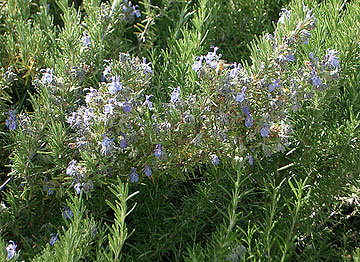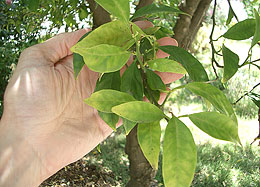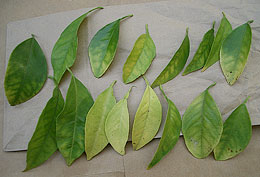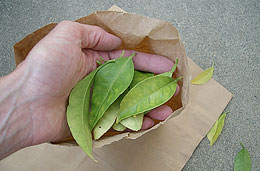Assessing plants
An integral part of sustaining a landscape irrigated with water of elevated salinity is to use appropriately salt-tolerant species of plants. For an existing landscape, examine any species already present that appear to be ailing. Try to determine whether the cause is related to salinity.
Bear in mind that a number of other causes unrelated to salinity sometimes elicit symptoms in plants that resemble the symptoms caused by salinity. Often it will be necessary to collect one or more samples of leaves or other plant materials for analysis by a horticultural laboratory. The results of such tests often can help to reveal whether a problem is caused by excessive salinity, inadequate nutrition, excessively high or low pH, or some other malady.
What to know about plants
To find out if any existing plants are showing signs of what's actually salt-related stress, sample parts of plants and submit them to an analytical laboratory. You'll want to determine the following:
- the concentration of sodium in each sample, expressed as a percentage
- the concentration of chloride in each sample, expressed as a percentage
- the concentration of boron in each sample, expressed in parts per million (ppm)
Concentrations of sodium, chloride, and boron exceeding the amount tolerated by more sensitive species of plants may cause injury.
Collecting samples of plant material
Collecting samples of plants typically involves the following:
-
Select an analytical laboratory that performs horticultural or agricultural testing of plant materials.
Make sure the laboratory conducts measurements of the concentrations of sodium, chloride, and boron in plants.
- Contact the laboratory of your choice. Its staff will furnish you with the needed forms and instructions and possibly also guidelines about sampling and bags for collecting samples.
- Samples from most plants are collected by hand. To collect samples from trees, you may need to take along pruning scissors, a pruning shear, and a small pruning saw. In some circumstances, a pole-mounted pruner and saw may be needed, too.
Unless the laboratory has provided some, obtain bags for collecting samples. Keep in mind that the samples must be kept dry. Any dampness would foster decay or the growth of secondary organisms. Thus, clean, dry paper bags are one option. If less than two days will elapse between collection and analysis, clean plastic bags could instead be used if a dry paper towel is placed in each bag to help absorb excess moisture and excess air is expelled by gently pressing each bag before closing it.
Keeping the samples cool is also a good idea. As part of your field kit, bring along a small or medium-sized insulated cooler for storing samples and transporting them to the laboratory.
-
Collect at least 5 or 10 clean, dry leaves. Pick entire leaves, including both the blades and the petioles — the stalks by which leaves are attached to stems. Laboratories use blades for some analyses and petioles for others. You'll need at least 3-1/2 ounces of leaves for each sample. For a species with small leaves, such as boxwood, you'll need to collect 15 to 20 or more leaves. For a species with large leaves, such as the London plane tree, 5 or 10 leaves may be enough.
Select leaves that are older and more exposed to the atmosphere instead of younger, more interior leaves. Salts accumulate in leaves over time, so the oldest ones will contain the highest levels of stored chemicals. Collect leaves exhibiting symptoms in one bag and those that do not in a different bag. The leaves within each bag should be of the same approximate age and from the same relative position within the plant.
When collecting samples from a tree, it's often a good idea to take samples of the bark and of the wood in branches, trunks, and roots, in addition to leaves. If the tree is obviously ailing, include samples of leaves, shoots, branches, or roots that demonstrate the transition from the ailing portion of the tree to the healthy portion.
- Label each sample bag right before you fill it. Indicate clearly the plant's location, its species, the part or parts collected, the date, and the name of the person who collected the sample.
- Place bagged samples in the storage container and transport them to the laboratory.
Since plants change as they grow and develop, you may need to collect samples several times during the year to include the early, middle, and late parts of the growing season.
Investigating salt tolerance
Different species of plants can have different tolerances to salinity, sometimes to a considerable degree. For an existing landscape, it's a good idea to check the tolerances to salinity of any plants likely to be retained. For a new landscape, check the tolerances of the various species under consideration.



